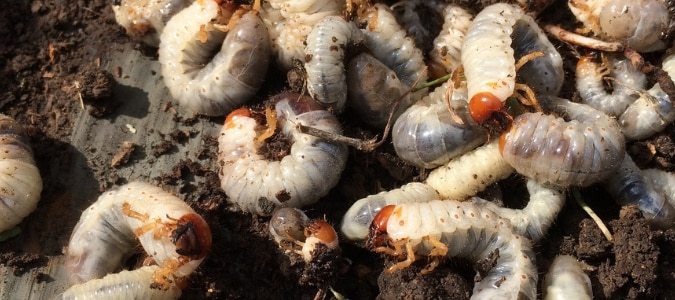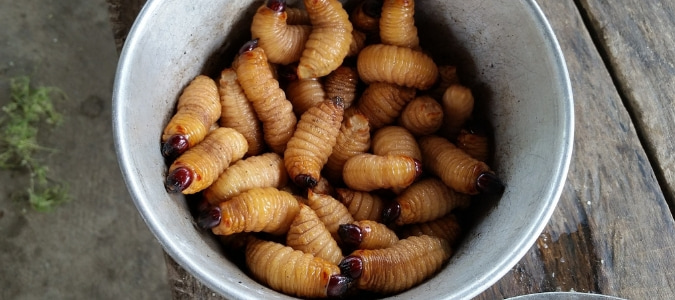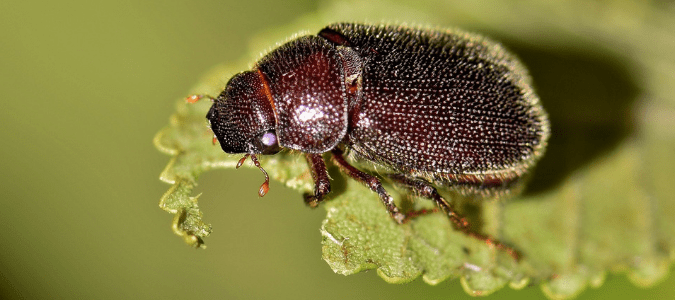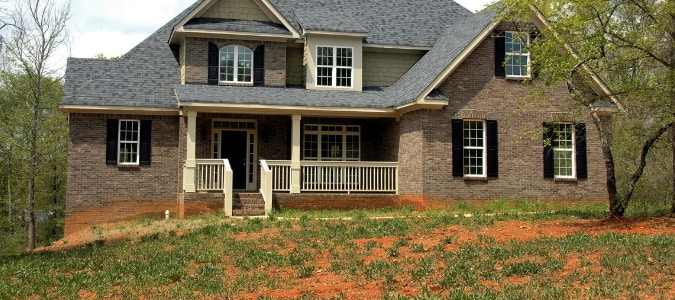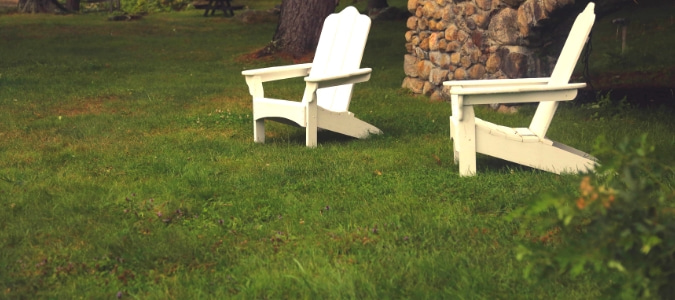
You used to have a great lawn. From the street, your yard was lush and green, with grass blades that swayed in the wind and glistened with dew in the morning.
Then, one day, you started noticing that patches were beginning to get thin. There were even brown patches.
What in the world was happening?
This isn’t a simple question to answer, because as any lawn expert will tell you, there are a number of possible culprits.
One of the most common lawn pests is grubs. Grub worms are common destroyers of lawns across America, and the south is no different—except that these critters tend to prefer warm-weather lawns. If you want to keep your yard healthy and looking good, you need to watch out for grubs.
What do grubs do that makes your lawn look thin and patchy? The short answer to this question is that these pesky critters eat it.
Exactly what they eat depends on the type of grub. Surface-dwelling lawn grubs feed on grass leaves. The larvae of the Japanese beetle and June grubs (also commonly referred to the May beetle) feed on tuft roots and other organic material found in the soil.
The caterpillar-like surface grubs are usually larval forms of moths and include species such as armyworms, cutworms and webworms.
We’re not going to spend a lot of time on these other species, though, because we want to focus on white grubs. Why? Because these types of grubs tend to feast on warm season grasses such as St. Augustine, Bermudagrass, buffalo grass and Zoysia grass.
So, exactly what is a grub worm?
What Are Grub Worms?
The white grub is actually a beetle in its larval stage, and these creatures are considered one of the most destructive turfgrass pests. Most grubs are fat and worm-like. They have soft, delicate bodies that can be squished easily.
Though the grub undergoes distinct changes in its size, color and shape throughout its life cycle, here are some of its most typical characteristics:
- All grub worm species have a cream-white (or dirty-white) body.
- The head of a grub is usually reddish or tan brown.
- A white grub’s tail end appears black or dark brown because the grub ingests soil as it feeds.
- A grub has three pairs of well-developed legs that are located laterally on the body, just below the grub’s head. The legs of the June Beetle grubs are, however, not well-developed.
- When disturbed, grubs curl into a characteristic C-position.
Now, let’s move onto the different types of grubs that might be feasting on your grass.
Types Of Grubs In Southern Lawns
The tail-end of a grub’s body has fine hairs arranged in a distinct pattern that is species-specific. The arrangement of these fine hairs is referred to as a “raster” pattern. The different species of grub worms can be accurately identified by studying their raster patterns.
The Japanese Beetle’s grub has a V-shaped raster pattern. The Northern Masked Chafer Beetle’s grub has a random, nondescript raster pattern. The European Chafer grub has a raster pattern that looks like an open zipper.
Japanese Grub
Japanese beetles have a life cycle that lasts for one year. The adult has copper-colored wings and a metallic green head. Along the sides of each wing of the adult beetle are six tufts of white hairs. The adult is about half an inch long. Grubs are about three-quarters of an inch long and can be found anywhere from two to six inches below the ground.
European Chafer Grub
The European chafer is an invasive grub species that is native to Europe. This beetle’s lifecycle also lasts for one year. The adult beetle is tan colored with an oval body and an average length of about half an inch. The grubs are usually found about two inches below the ground and are about three-quarters of an inch long.
June Beetle Grub
The adult June beetles (also sometimes known as May beetles or June bugs) are brown-to-black colored and oval. They measure about three-quarters of an inch length and generally have a longer life cycle that can take up to three years. The grubs are large and may grow to about an inch and a half.
Other species of lawn grubs include:
- Asiatic Garden Beetle Grubs
- Oriental Beetle Grubs
- Black Turfgrass Ataenius Grubs
- Southern and Northern Masked Chafer Grubs
- Green June Beetle Grubs
Now that we’ve talked more about the types of grubs you might come across, let’s talk more about the life cycle of this common lawn pest.
Where Do Grubs Come From?
To fully understand where grub worms come from, we must first explore a beetle’s life cycle. Like most insects, the beetle has a four-stage life cycle that starts when an adult lays an egg. The egg hatches into a larva. The larva then transforms into a pupa. The pupa completes the cycle by becoming an adult beetle.
The Egg
After adult beetles mate, the female looks for a grassy location on a sunny lawn and lays her egg in shallow holes in the soil underneath the grass.
Beetles lay their eggs in summer. The European Chafer, for instance, lays her eggs in June, the Japanese beetle lays in July and August while the June beetle does it in—you guessed it—May and June.
The laying of eggs takes about two or three weeks, and each female lays around 60 eggs. Soil moisture and temperature are the two main determinants of how fast the eggs hatch.
Beetle eggs generally hatch into larva after about two weeks.
The Larva
A beetle’s larva is the grub. Grub worms grow in stages, progressing from what’s called the 1st instar to the 2nd instar to the 3rd instar. Most grubs take one year to mature. Nonetheless, there are exceptions. The Black Turfgrass Ataenius, for instance, takes two years to mature, while the June grub takes three years to become an adult.
The 1st instar is a tiny, newly-hatched grub. It feeds close to the ground surface, eating grass roots throughout the month of August. Due to their small size, first-instar grubs are hard to notice, and their destructive effect on a lawn may go unnoticed. However, they are very vulnerable to both biological and chemical agents of pest control.
The grub molts into the 2nd and 3rd instars in October. Each time it molts, the grub grows in size and subsequently its food consumption increases. Because of this, it’s far easier to notice the damage that 2nd and 3rd instar grubs cause to a lawn. Since 3rd instar grubs are the largest, they cause most of the damage, due to their voracious appetites and high demand for food. A large number of 3rd instar larva will destroy the turfgrass root system in your lawn in a matter of days.
In autumn, as the temperatures begin to drop, grub worms burrow deep into the soil to escape the winter’s cold. They overwinter in their holes as 3rd instar grubs. During this stage, the grub doesn’t feed. It relies on stored-up fat for energy and nutrition.
In spring, as temperatures begin to rise, the grubs crawl out of their underground holes and burrow their way into the root system of your lawn grass. They now feed aggressively, given that they are ravenous from the winter-long hibernation.
However, much of the lawn damage seen in spring due to grub worms is actually a result of feeding in the previous autumn. The grubs will continue feeding until mid-May when they pupate.
Pupa
In late spring, a hard exoskeleton develops around the grub as it transforms into a pupa. The pupa doesn’t feed. During this life stage the creature is resistant to most pesticides. The pupa stays in the soil for several weeks, after which an adult emerges at the beginning of summer.
The Adult Beetle
A grub’s life cycle ends when an adult beetle reaches maturity. Adult beetles usually mate for around two to three weeks, females lay eggs, and the cycle begins all over again.
Can You Predict Grub Worm Damage?
As adult beetles fly around, they are always on the lookout for full-sun lawns that are well-watered. Therefore, even though many other factors may factor into how many grubs end up on your lawn, the presence of adult beetles in July or summer is a good indicator of an impending lawn grub infestation.
A lawn owner should, therefore, watch his or her lawn closely beginning mid-August and throughout September. If there are any signs of wilting and browning patches, lawn grubs may be responsible.
The damage caused by grubs may vary in extent and severity, from minor and barely noticeable to severe. A variety of variables can affect the rate and intensity of damage. Nonetheless, it’s usually the heaviest infestations that cause the most damage.
A lawn grub is most destructive during its larval stages, during which it feeds aggressively on the roots of lawn grass, causing the plants to wilt and die. Initially, the damage caused by grubs resembles drought stress, which is often confusing to homeowners. The grubs may also feed on other underground parts of the lawn tuft.
Once the root system is gone and underground parts of your grass get damaged, the tuft loses its vigor, turns brown and eventually dies off. Spongy patches will then appear on your lawn. The grass in these areas will gradually get ripped away and torn apart.
White grubs do most of their damage starting midsummer through to early autumn. They cause irregularly-shaped patches of weakened, dry grass that can easily be pulled from the ground. Usually, the grass whose root system has been destroyed by grubs can be rolled back like a rug or carpet.
Since there are various other causes of dried up lawn patches, you can confirm grub activity by digging around in the soil near the affected parts to see whether these creatures are present in the top few inches.
Grubs also cause indirect lawn damage by attracting predators. Animals such as skunks, birds, and raccoons may dig away and rip out parts of your grass as they look for grubs to eat.
ABC Can Protect Your Lawn
It’s unlikely that a small number of grubs will do much harm to your lawn. However, if grubs cause significant damage, you’ll need to call in an expert who will get rid of grubs from your lawn and protect your lawn from future grub worm attacks and yard fungus. ABC Home & Commercial Service’s lawn experts can rehabilitate, renovate and restore your lawn to its former beauty. As a full-service lawn provider, we take care of any problem you are having with your grass, trees or landscaping, as well as handle regular mowing and seasonal cleanups. With ABC’s help, your lawn will be the envy of the neighborhood.
